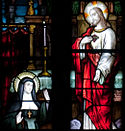
Savona is a seaport and comune in the west part of the northern Italian region of Liguria, capital of the Province of Savona, in the Riviera di Ponente on the Mediterranean Sea.
Our Lady of Ipswich was a popular English Marian shrine before the English Reformation. Only the shrine at Walsingham attracted more visitors.
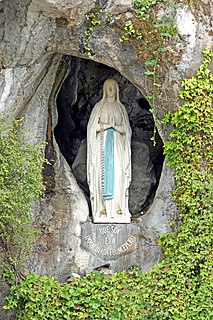
Our Lady of Lourdes is a Roman Catholic title of the Blessed Virgin Mary venerated in honour of the Marian apparitions that are claimed to have occurred in 1858 in the vicinity of Lourdes in France. The first of these is the apparition of 11 February 1858, when 14 year-old Bernadette Soubirous told her mother that a "lady" spoke to her in the cave of Massabielle while she was gathering firewood with her sister and a friend. Similar apparitions of the "Lady" were reported on 18 occasions that year, until the climax revelation of Our Lady of the Immaculate Conception took place.
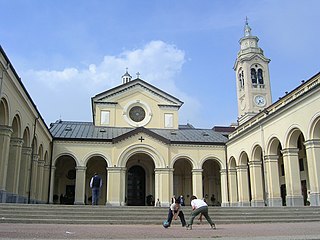
Ceranesi is a comune (municipality) in the Metropolitan City of Genoa in the Italian region Liguria, located about 11 kilometres (7 mi) northwest of Genoa.

The Sanctuary of Nostra Signora della Misericordia is a church and surrounding buildings located some six kilometers from the center of Savona, Liguria, northern Italy.

Bolzaneto is a quarter of the city of Genoa, in northwest Italy, and is part of the Municipality Valpolcevera of Genoa.
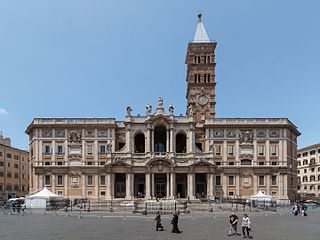
Roman Marian churches are religious buildings dedicated to the veneration of the Blessed Virgin Mary. These churches were built throughout the history of the Catholic Church, and today they can be found on every continent including Antarctica. The history of Marian church architecture tells the unfolding story of the development of Roman Catholic Mariology.

Monte Figogna is a mountain in Liguria, northern Italy, part of the Ligurian Appennines. It is located in the Municipality of Ceranesi, about 20 km from the city of Genoa. It lies at an altitude of 804 metres. In Ligurian, the mountain is called Monte Fighêugna.

The Pontifical Shrine of the Blessed Virgin of the Rosary of Pompei is a Roman Catholic cathedral, Marian pontifical shrine and minor basilica commissioned by Bartolo Longo, located in Pompei, Italy. It is the see of the Territorial Prelature of Pompei.
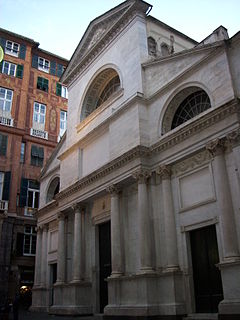
Santa Maria delle Vigne is a Roman Catholic basilica church in Genoa, Italy. It was built in the 10th century. The main altar was completed in 1730 by Giacomo Antonio Ponsonelli. The church is also the final resting place of the leading early Italian composer Alessandro Stradella, who was murdered in 1682.
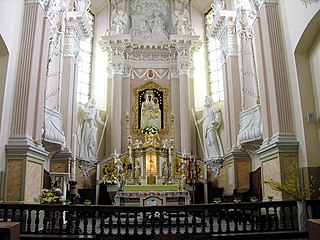
Our Lady of Šiluva is Roman Catholic icon of the Virgin Mary in Šiluva, Lithuania. A shrine of the same name has been built and is dedicated to her. The icon is highly venerated in Lithuania and is often called "Lithuania's greatest treasure".

The Chiesa della Santissima Trinità dei Pellegrini is a Roman Catholic church located on Via dei Pettinari #36 In the rione of Regola of central Rome, Italy. It stands a block away from the Palazzo Spada on Via Capo di Ferro, while a few blocks away on the Via dei Pettinari stands the Ponte Sisto.
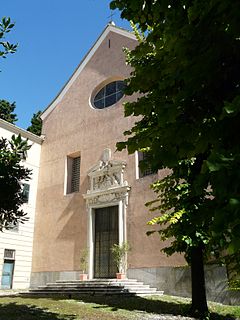
The Church of Saint Anne, with the adjacent convent and pharmacy of the Discalced Carmelites, is a Roman Catholic church located in the residential quarter of Castelletto in Genoa, Liguria, north-western Italy. The village - now surrounded by the city - is still intact, with its leafy trees, cobbled walkways and open views from Salita Bachernia over the Gulf of Genoa, the harbor and the Old City.
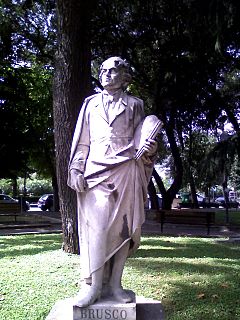
Paolo Gerolamo Brusco or Girolamo Brusco was a prolific Italian painter active in Liguria. He was also nicknamed Bruschetto.

The Sanctuary of Our Lady of Montallegro is a major Marian sanctuary in the Province of Genoa, located on a hill inland in Rapallo. It was built - along with the annex shelter for pilgrims - in 1558 thanks to the funds of the inhabitants. The current marble facade was built in 1896 by the Milanese architect Luigi Rovelli and opened with a solemn ceremony on June 21 of that year. Our Lady of Montallegro is the patroness of the city of Rapallo from 1739, when she was elected as the patron saint of the community rapallese, his Captaincy and the parishes of Santa Margherita Ligure. This recognition is reproduced on the municipal coat of arms showing from 28 November 1948 a letter "M" in the center of the two griffins below the royal crown. The hymn of Our Lady of Montallegro, entitled shines on high, was composed and set to music by teacher and priest Giovanni Battista Campodonico.

The Brughiera sanctuary is a sanctuary devoted to the Virgin Mary in the comune of Trivero in northern Italy.

Prè is a neighbourhood in the old town of the Italian city of Genoa. It was one of the six sestieri of ancient Genoa. At present it is part of the Genoa's city I Municipio. Located close to the old harbour, it is likely the best-known neighbourhood of the old town of Genoa.
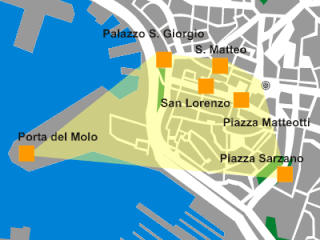
Molo is a neighbourhood in the old town of the Italian city of Genoa. It was one of the six sestieri of ancient Genoa. At present is part of the Genoa's city Municipio I.























